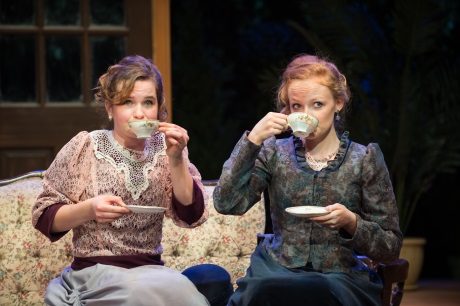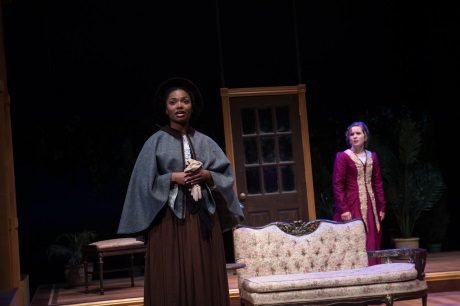I lost count of how many orgasms are in this show. They keep, um, coming and coming. And each one is performed stunningly by a student actor with such precisely differentiated paroxysms and vivid vocalization, and with such intrinsic dramatic interest, that they become playlets within the play, each a showstopper jaw-dropper.

And those Big Os are only a few of the pleasures to be had in the excellent production directed by Derek Goldman at Georgetown University of Sarah Ruhl’s In the Next Room or the vibrator play, a 2010 Pulitzer Prize finalist and Tony Award nominee. I caught the show near the end of its run, and the enthusiastically responsive audience suggested to me that word of mouth had made it a campus hit. Certainly the acting, design, and direction combined with Ruhl’s script were of a caliber that could easily have made it a hit with the larger audience of theater fans as well.
Ruhl’s play tells an audacious story, much of it based on historical fact, about the titular vibrator, which was made possible by the invention of electricity. Early use was made of this clever gizmo to treat “hysteria” in women (and on occasion men). Offered to patients in a clinical setting by medical professionals of the time, supervised stimulation to orgasm by vibrator had a salutary therapeutic effect—symptoms of hysteria subsided or disappeared. So these coming attractions generated quite a buzz.

Stage left is the proper 19th-century parlor of Dr. Givings (an earnest and forthright Alex Prout) and his wife Mrs. Givings (an impressive and vivaciously versatile Michaela Farrell). Stage right is the titular next room, an office with an examining table upon which the doc treats his patients to peak experiences.
The first patient of Dr. Givings we meet is Mrs. Daldry (a fascinatingly high-strung Healy Knight, whose hilarious scenes with Farrell pretty much walk away with the show). She arrives with her dud-in-bed husband Mr. Daldry (an amusingly unremarkable Charlie Tepany). He’s dispatched to take a walk, though, so that Mrs. Daldry can be seen by the doctor in his office, attended by his assistant Annie (Vanessa Chapoy, whose dazed but unfazed takes on the proceedings made me smile). Mrs. Daldry disrobes to her Victorian undergarments and lies apprehensively on the examining table covered by a sheet. With nonplussed Annie standing by, the practiced doctor does his thing. His thingamajig locates her thingamabob and ecstasy ensues.
We meet the second patient of Dr. Givings at the top of Act Two—a flamboyant Italian artist named Leo (a dashing and kinetic Alec Meguid), whose poetic odes to female beauty in art and life charm both the Mesdames. Turns out he’s got symptoms that Dr. Givings recognizes as hysteria. Ruhl, in a startling but astute plot twist, has a scene with Leo under the sheets having his prostate palpated by the doctor’s electrical dildo. So it is that we get Leo’s ecstasy in excelsis.

Mrs. Givings gets a turn being turned on too—she is the last of three characters to orgasm spectacularly during the show—but her ecstasy comes of a connection between her and Mrs. Daldry, not at the hands of her hubby. This instance makes her realize what’s been missing from her marital bed, and she sets about getting it, with surprising results quite tender and touching.
There is not a moment in the play when Ruhl is not thoroughly in command of the gendered meanings in what she’s doing. There is also a subplot with which Ruhl brilliantly leads us to see the raced meanings of the play. Mrs. Givings has just given birth to a baby but is not lactating sufficiently. She then enlists an African American wet nurse named Elizabeth (an affectingly stoic Nona Johnson). The story lines that follow (including Leo’s patronizing painting of Elizabeth nursing the Givings’ baby) have a profound effect on the whole play in framing the action as privileged white people’s problems.
Set Designer Andrew Cohen, one of several professionals on the creative team, does a fantastic job. Among the nice touches are the two large images framed and mounted on opposite walls: a romanticized painting of a woman in the posh living room and a clinical diagram of a woman’s body in the medical office. Just as Ruhl’s play tracks the gender dichotomy, Cohen sets up a dramatic contrast between a female-friendly world stage left and a starkly male world stage right.
Lighting Designer Kristin A. Thompson fluidly shifts focus between the two worlds, and creates a delightful cue that dims the office lights whenever power is being drawn by the vibrator. A very talented student sound designer, Sean Craig, lends a humming-buzzing undertone to the happiness appliance. Prop Designers Deb Crerie and Kay Rzasa get credit for, among other things, the doctor’s very credible implements. And Costume Designer Debra Kim Sivigny’s period garments are, especially for the women, magnificent in every detail right down to their underwear.
In the Next Room is the third main-stage production I’ve seen at Georgetown (the other two were War With the Newts and Wind Me Up, Maria!: A Go-Go Musical, both directed by Natsu Onoda Power), and I’m beginning to conclude that GU has one of the top must-see university theaters in town.
Running Time: About two hours and 20 minutes, including one intermission.
In the Next Room or the vibrator play plays through April 8, 2017, at the Davis Performing Center’s Gonda Theatre at Georgetown University – 37th & O Streets NW, in Washington, DC. For tickets, purchase them online.




